A Comprehensive Review: Advances in Deep Learning for Lung Disease Diagnosis Using Medical Imaging
Main Article Content
Abstract
Lung diseases with pneumonia, tuberculosis, chronic obstructive pulmonary disease, and lung cancer keep on major global health concerns, contributing to millions of deaths annually. Appropriate and precise diagnosis, primarily through medical imaging techniques such as chest X-rays and computed tomography, acting an essential role in effective treatment. Though, the shortage of expert radiologists and human limitations in interpretation complex images often lead to diagnostic delays and errors. The advancement in deep learning has extensively improved the capability of automated lung disease detection, leveraging architectures such as convolutional neural networks, vision transformers, and hybrid models. This broad review presents the evolution and impact of DL in lung disease diagnosis using medical imaging and analyzes performance across various architectures, explore benchmark datasets, and identifies persistent challenges such as data imbalance, model interpretability, and deployment barriers. The study underlines solutions including generative adversarial networks, explainable AI (XAI), and federated learning to deal with real-world boundaries. In addition, ethical considerations, case studies, and future directions are discussed to facilitate the development of transparent, fair, and reliable AI tools for global clinical use.
Downloads
Article Details
Section

This work is licensed under a Creative Commons Attribution-NonCommercial 4.0 International License.

